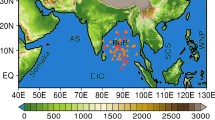Abstract
Trends in tropical cyclone (TC) genesis and landfall over the Bay of Bengal (BOB) were analysed to identify global warming and climate change impacts. The historical TC data for the period 1901–2015 available through the cyclone eAtlas from India Meteorological Department were used. The analysis was confined to the 3-month period from October to December when the maximum number of TCs occurs over the BOB. Analysis was conducted for the two 50-yr periods of 1901–1950 and 1961–2010 and the four 30-yr periods of 1921–1950, 1961–1990, 1971–2000 and 1981–2010 to ascertain the differences and tendencies in the genesis and landfall points during the current global warming era since the 1960s and the previous years. The results indicate an increase of TC genesis over the south-east and central BOB and decrease over the south central region. Furthermore, an increased vulnerability of the Bangladesh coastline to TC landfall was detected. In addition, TC systems had decreased in number but increased in intensity. These results confirm the general reports of TC trends over the BOB as of other ocean basins in the post-industrialisation global warming era.





Similar content being viewed by others
References
Bhaskar Rao D V, Naidu C V and SrinivasaRao B 2001 Trends and fluctuations of the cyclonic systems over North Indian Ocean; Mausam 52 1–8.
Brohan P, Kennedy J J, Haris S F B, Tett I and Jones P D 2006 Uncertainty estimates in regional and global observed temperature changes: A new dataset from 1850; J. Geophys. Res. 111 D12106.
Christensen J H, Krishna Kumar K, Aldrian E, An S-I, Cavalcanti I F A, de Castro M, Dong W, Goswami P, Hall A, Kanyanga J K, Kitoh A, Kossin J, Lau N-C, Renwick J, Stephenson D B, Xie S-P and Zhou T 2013 Climate phenomena and their relevance for future regional climate change; In: Climate change 2013: The physical science basis. Contribution of working group I to the fifth assessment report of the intergovernmental panel on climate change (eds) Stocker T F, Qin D, Plattner G-K, Tignor M, Allen S K, Boschung J, Nauels A, Xia Y, Bex V and Midgley P M, Cambridge University Press, Cambridge, UK and New York, NY, USA, pp. 1217–1308.
Diaz H F and Pulwarty R S (eds) 1997 Hurricanes: Climate and socioeconomic impacts; Springer-Verlag, p. 292.
Elsberry R L 1995 Recent advancements in dynamical tropical cyclone track predictions; Meteorol. Atmos. Phys. 56 81–99.
Gray W M 1968 Global view of the origin of tropical disturbances and storms; Mon. Weather Rev. 96 669–700.
India Meteorological Department 2008 Report on Cyclonic Disturbances over North Indian Ocean during 2007; India Meteorological Department, New Delhi, India.
India Meteorological Department 2009 Report on Cyclonic Disturbances over North Indian Ocean during 2008; India Meteorological Department, New Delhi, India.
IPCC 2007 Summary for policymakers; In: Climate change 2007: The physical science basis. Contribution of working group I to the fourth assessment report of the intergovernmental panel on climate change (eds) Solomon S, Qin D, Manning M, Chen Z, Marquis M, Averyt K B, Tignor M and Miller H L, Cambridge University Press, Cambridge, UK and New York, NY, USA, pp. 1–996.
IPCC 2013 Summary for policymakers; In: Climate change 2013: The physical science basis. Contribution of working group I to the fifth assessment report of the intergovernmental panel on climate change (eds) Stocker T F, Qin D, Plattner G K, Tignor M, Allen S K, Boschung J, Nauels A, Xia Y, Bex V and Midgley P M, Cambridge University Press, Cambridge, UK and New York, NY, USA, p. 28.
Poli P, Hersbach H, Dee D P, Berrisford P, Simmons A J, Vitart F, Laloyaux P, Tan D G, Peubey C, Thépaut J, Trémolet Y, Hólm E V, Bonavita M, Isaksen L and Fisher M 2016 ERA-20C: An atmospheric reanalysis of the twentieth century; J. Clim. 29 4083–4097.
Rahmstorf S, Foster G and Cahill N 2017 Global temperature evolution: Recent trends and some pitfalls; Env. Res. Lett. 12 054001.
Sellers H A, Zhang H, Berz G, Emanuel K, Gray W, Landsea C, Holland G, Lighthill J, Shieh S-L, Webster P and McGuffie K 1998 Tropical cyclones and global climate change: A post-IPCC assessment; Bull. Am. Meteor. Soc. 79 19–38.
Smith T M and Reynolds R W 2003 Extended reconstruction of global sea surface temperature based on COADS data (1854–1997); J. Clim. 16 1495–1510.
Smith T M, Reynolds R W, Peterson T C and Lawrimore J 2008 Improvements to NOAA’s historical merged land–ocean surface temperature analysis (1880–2006); J. Clim. 21 2283–2296.
Walsh K J E and Jack J K 2000 The impact of climate change on the poleward movement of tropical cyclone–like vortices in a regional climate model; J. Clim. 13 1116–1132.
Wu L and Wang B 2004 Assessing impacts of global warming on tropical cyclone tracks; J. Clim. 17 1686–1698.
Acknowledgements
Tropical cyclone track data for the north Indian Ocean in the form of eAtlas from the India Meteorological Department were accessed. The open access SST data from National Oceanic and Atmospheric Administration and atmospheric data from ERA-20C from the European Centre for Medium-Range Weather Forecast have been used.
Author information
Authors and Affiliations
Corresponding author
Additional information
Communicated by Kavirajan Rajendran
Rights and permissions
About this article
Cite this article
Bhaskar Rao, D.V., Srinivas, D. & Satyanarayana, G.C. Trends in the genesis and landfall locations of tropical cyclones over the Bay of Bengal in the current global warming era. J Earth Syst Sci 128, 194 (2019). https://doi.org/10.1007/s12040-019-1227-1
Received:
Revised:
Accepted:
Published:
DOI: https://doi.org/10.1007/s12040-019-1227-1




